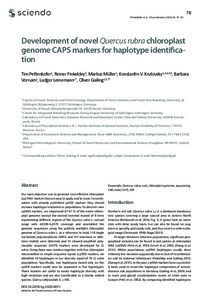Development of novel Quercus rubra chloroplast genome CAPS markers for haplotype identification : научное издание
Скачать файл:
DOI:
10.2478/sg-2020-0011URI (для ссылок/цитирований):
https://elib.sfu-kras.ru/handle/2311/137955Автор:
Pettenkofer Tim
Finkeldey Reiner
Mueller Markus
Krutovsky Konstantin
Vornam Barbara
Leinemann Ludger
Gailing Oliver
Дата:
2020Журнал:
SILVAE GENETICAКвартиль журнала в Scopus:
даКвартиль журнала в Web of Science:
даСтатья из журнала. Научное издание.
Аннотация:
Our main objective was to generate cost-effective chloroplast (cp) DNA markers that are easy to apply and to score. In combination with already published cpSSR markers they should increase haplotype resolution in populations. To discover new cpDNA markers, we sequenced 87-97 % of the entire chloroplast genome (except the second inverted repeat) of 8 trees representing different regions of the Quercus rubra L natural range with 4,030X-6,297X coverage and assembled the genome sequences using the publicly available chloroplast genome of Quercus rubra L. as a reference. In total, 118 single nucleotide polymorphisms (SNPs) and 107 insertions or deletions (indels) were detected, and 15 cleaved amplified polymorphic sequence (CAPS) markers were developed for Q. rubra. Using these new markers together with five chloroplast microsatellite or simple sequence repeat (cpSSR) markers, we identified 10 haplotypes in our diversity panel of 19 Q. rubra populations. Specifically, two haplotypes based only on the cpSSR markers could now be separated in five haplotypes. These markers are useful to assess haplotype diversity with high resolution and are also transferable to a closely related species, Quercus ellipsoidalis E. J. Hill.
Our main objective was to generate cost-effective chloroplast (cp) DNA markers that are easy to apply and to score. In combination with already published cpSSR markers they should increase haplotype resolution in populations. To discover new cpDNA markers Our main objective was to generate cost-effective chloroplast (cp) DNA markers that are easy to apply and to score. In combination with already published cpSSR markers they should increase haplotype resolution in populations. To discover new cpDNA markers

